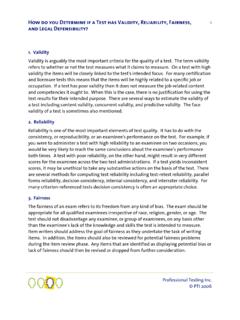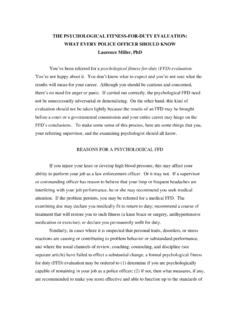Transcription of EFPT -Test Booklet
1 Test Protocol Booklet May 2007 Executive Function Performance Test Carolyn M. Baum, Tracy Morrison, Michelle Hahn, Dorothy F. Edwards Program in Occupational Therapy Washington University School of Medicine St. Louis, MO USA We have had the review and consultation from many colleagues in the development of the EFPT. We particularly want to acknowledge Heidi Schambra, Research Assistant and now physician for her early work on the instrument; Noomi Katz, PhD, OTR and Adina Hartman Maeir, PhD, OT from Hebrew University and Naomi Josman, PhD, OTR from Haifa University in Israel; Deirdre Dawson, PhD, OT(C), the Rotman Centre in Toronto and Jen Murawski, MSOT from Washington University for their contributions to the conceptual development of the instrument. Much of the work that developed the EFPT was funded by the James S. McDonnell Foundation Grant No. 21002032. Baum, Morrison, Hahn & Edwards, 2007 Preface The Executive Function Performance Task was developed at the Program in Occupational Therapy at Washington University Medical School in St.
2 Louis, MO. The Kitchen Task Assessment (KTA), an earlier functional assessment test designed by Carolyn Baum and Dorothy Edwards (1993), was used as the prototype in developing the EFPT. Like its predecessor, the EFPT is used to provide a performance-based standardized assessment of cognitive function (Baum and Edwards, 1993). Generally, traditional neuropsychological tests follow a bottom-up approach to analyzing brain function: the tests gather information about specific aspects of cognition, such as memory, attention, or planning (Duchek, 1997). Although this micro-level assessment gives an accurate depiction of specific cognitive impairments, the relationship between components of cognition and overall functional ability is unclear. Conversely, the EFPT takes a macro-level view of cognition: functioning as a whole is examined as individuals perform an entire task. It cannot be assumed that an impairment in a cognitive process will result in an impairment in overall functional capacity (Abreu et al.)
3 , 1994h, Lowenstein et al., 1995). Therefore, it is unwise to base an intervention strategy solely on the results of a neuropsychological battery, which may be insufficient to determine an individual s overall ability to function. The results of the bottom-up tests should be supplemented with top-down functional assessments. More insightful interventions can be created with a combination of these two assessment strategies. The EFPT, a top-down functional assessment test, was designed to examine total cognitive integration and functioning in an environmental context. The EFPT specifically examines executive functions. Executive functions are a group of cognitive processes which mediate goal-directed activity (Kaye et al., 1990; Stuss, 1992). Thus executive functions are involved in task execution. The EFPT serves three purposes: (1) to determine which executive functions are impaired. (2) to determine an individual s capacity for independent functioning.
4 (3) to determine the amount of assistance necessary for task completion. Unlike other tests of function, the EFPT does not examine what individuals cannot do. Rather, it identifies what they can do, and how much assistance is needed for them to carry out a task. The EFPT does not simply discriminate between individuals who can do the test and those who cannot. By using a cueing system, a wider range of abilities are captured in people previously thought to be untestable. This cueing system is standardized and associates with the degree of cognitive impairment. Finally, the cueing system gives the tester a straightforward assessment of required assistance. The EFPT examines the execution of four basic tasks that are essential for self-maintenance and independent living: simple cooking, telephone use, medication management, and bill payment. The EFPT assesses an individual s ability to complete the following components of the task (an elaboration of definitions is given in Table 1): initiation of task execution of task (requiring organization, sequencing, and judgment and safety) completion of task During each task, cognitive functions fluidly interact and co-occur.
5 The rater observes task performance, focusing specifically on executive functions. The level of cueing necessary to support task performance is recorded as a score. Thus, the score reflects the participant s capacity for executive functioning that has been observed during performance of each task. For example, if the individual is unable to initiate the task, the rater can determine that the executive function underlying initiation is defective and plan a strategy to address this deficit. Steps are the discrete movements which, cumulatively, comprise an action. Actions, in turn, are combined to perform the task (Christiansen and Baum, 1997, p. 57). For example, an individual will reach for a spoon, grasp it, pick it up, place it in the oatmeal, and move it in a circular motion (the steps) in order to stir oatmeal (the action). At a fundamental level, the execution of a task requires the ability to correctly sequence and attend to steps, as well as the abilities to organize tools and utilize judgment to ensure safety.
6 These requirements must be met in order for successful task completion. Initiation, execution, and completion have been operationally defined to guide the development of this test. Using these definitions, the rater is able to analyze the executive functions that mediate each task. Accordingly, the EFPT allows the rater to observe how executive functioning is impaired in the individual, and the type and amount of help needed to maintain self-sufficiency can be ascertained and shared with caregivers. The EFPT is a formal cognitive test which requires strict adherence to testing protocol. There should be no modifications of the instructions. Any deviation from standard testing procedure will decrease validity. In order to avoid bias, the rater must not form preconceived ideas about the participant s capacity to perform the tasks. All test items must be administered regardless of the participant s preferences or experiences towards/with task items.
7 The EFTP was designed to accommodate all levels of functioning and to establish the levels of support needed for a range of tasks. Therefore, all participants can be scored on this measure, especially because it is possible to score when physical assistance is provided and when the person is not able to perform the task. Table 1 Executive Function Component Definition Expected Behavior Initiation the advent of motor activity that commences a task (DePoy et al., 1990; Kaye et al., 1990; Weld & Evans, 1989).* The individual moves to the materials table to collect items needed for the task. Execution the proper completion of each step, consisting of three requirements: organization, sequencing, and safety and judgment (see below). The individual carries out the steps of the task without incident. Organization the physical arrangement of the environment, tools, and materials to facilitate efficient and effective performance of steps (Weld & Evans, 1990).
8 The individual correctly retrieves and uses the items that are necessary for the task. Sequencing the coordination and proper ordering of the steps that comprise the task, requiring a proper allotment of attention to each step (Lezak, 1989). The individual carries out the steps in an appropriate order, attends to each step appropriately, and can switch attention from one step to the next. Judgment and Safety the employment of reason and decision-making capabilities to intentionally avoid physically, emotionally, or financially dangerous situations. The individual exhibits an awareness of danger by actively avoiding or preventing the creation of a dangerous situation. Completion the inhibition of motor performance driven by the knowledge that the task is finished (Baum and Edwards, 1993).** The individual indicates that he/she is finished or moves away from the area of the last step. * It is important to make the distinction between a motor action that begins the task and a motor action that precedes the task.
9 An excess of the latter is considered self-regulation deficit, a dissociation between intention and action. In this case, the individual will talk about a task or make gesticulations that resemble movements needed later in the task ( , stirring motion, hand wringing), but he or she will not carry out the task (Lezak, 1989). ** Two cognitive factors may contribute to difficulty in completing a task: (1) an inability to disengage attention from the final step, , acknowledgment that the task is complete, or (2) perseveration, an inability to disengage motor response from the task (Lezak, 1989). Both factors may lead to a persistence in continuing the task. Cueing Guidelines: Unless the participant is in danger ( , putting the pitcher of water down where it could fall off the table and break, putting a hot pad on the burner, touching the burner to see if it is on, placing their sleeve in the fire, etc.), do not intervene until the participant shows he/she is struggling with the next step.
10 If the person has difficulty with any aspect of any of the tasks, you must wait at least 10 seconds (to observe processing) before giving the participant a cue. Give two cues of each kind before progressing to the next cueing level. Give cues progressively (see below) from verbal guidance gestural guidance direct verbal assistance physical assistance. If the participant is still unable to perform a step in a task, the examiner should do the step for him/her, then the participant should be cued back to the next sequential step of the task. You will often find yourself combining different levels of cues. The score of your degree of assistance must reflect the highest level of cue used to get the task done. Do not initiate conversations during the test, and do not cheer lead, , do not give positive or negative feedback. Cueing Descriptions: No Cues Required: The participant requires no help or reassurance, does not ask questions for clarification, goes directly to the task and does it.









